Thesis: Role of Consultant in Successful Construction Projects
VerifiedAdded on 2020/01/07
|81
|12422
|28
Thesis and Dissertation
AI Summary
This thesis delves into the pivotal role of consultant engineers in construction projects, examining their responsibilities from inception to completion. It highlights the importance of project management consultancy in enhancing project efficiency, particularly within the UAE's construction landscape. The research encompasses both infrastructural and real-estate sectors, with a focus on design and supervision stages. The study analyzes nine key project success factors and how consultants can influence them. The thesis emphasizes the necessity of adhering to project management principles to ensure timely and error-free project delivery, addressing challenges such as obtaining construction permits and navigating complex regulations. The research also includes a case study from GULF SKY Engineering Consultant, providing practical insights into project quality management and its impact on stakeholders, including tenants and owners. The work provides recommendations based on the findings and emphasizes the importance of risk management and quality control throughout the construction process.
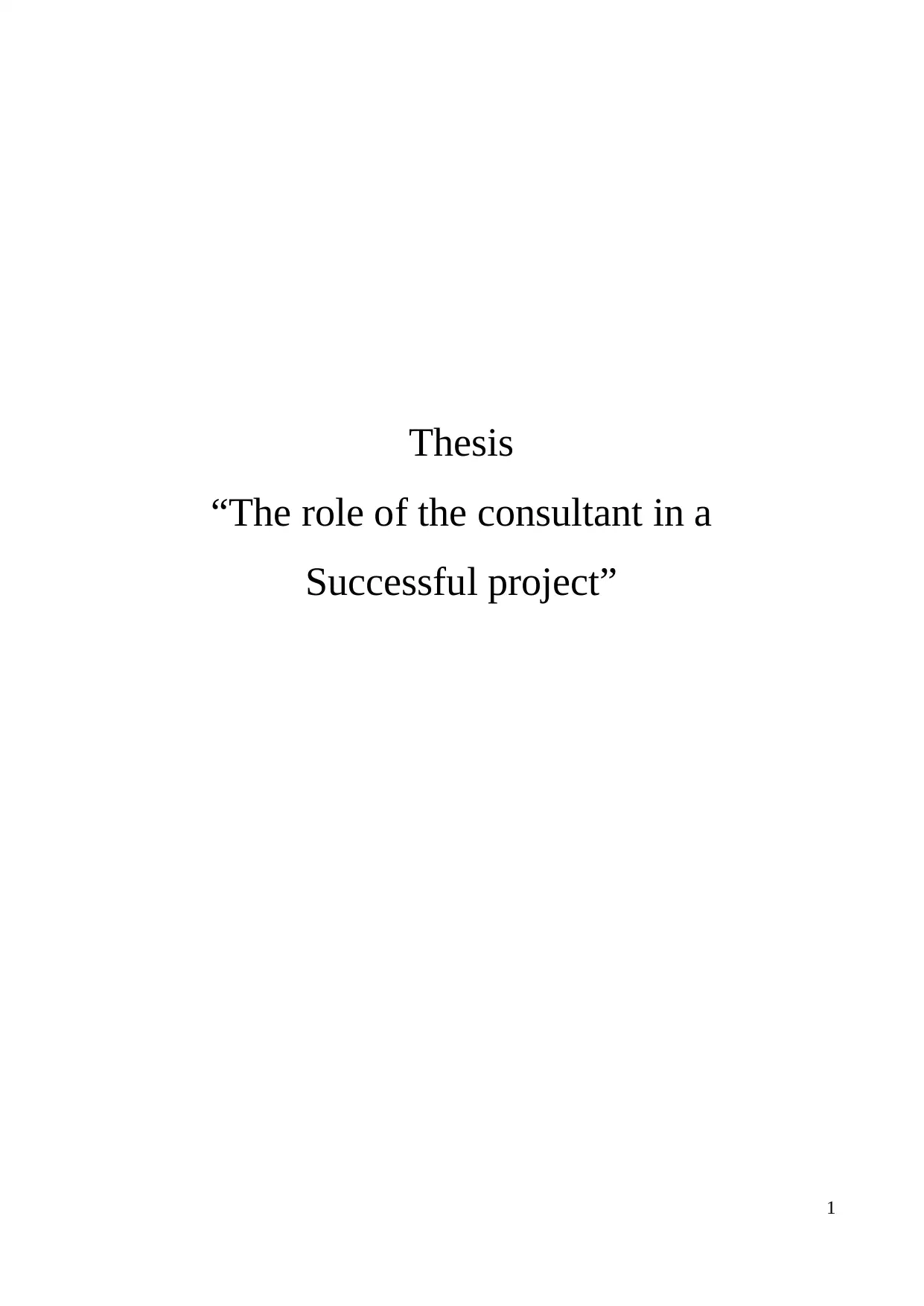
Thesis
“The role of the consultant in a
Successful project”
1
“The role of the consultant in a
Successful project”
1
Paraphrase This Document
Need a fresh take? Get an instant paraphrase of this document with our AI Paraphraser
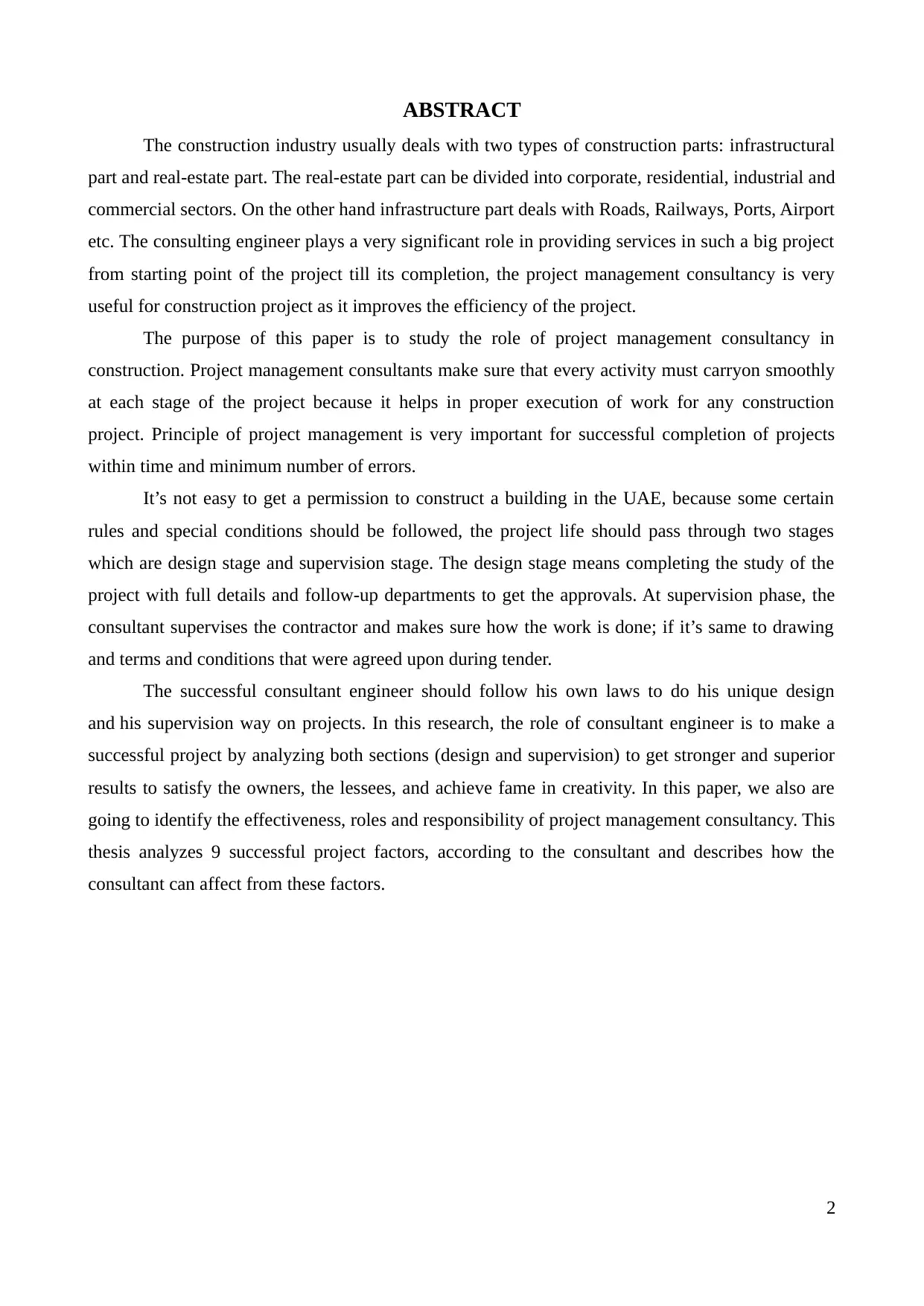
ABSTRACT
The construction industry usually deals with two types of construction parts: infrastructural
part and real-estate part. The real-estate part can be divided into corporate, residential, industrial and
commercial sectors. On the other hand infrastructure part deals with Roads, Railways, Ports, Airport
etc. The consulting engineer plays a very significant role in providing services in such a big project
from starting point of the project till its completion, the project management consultancy is very
useful for construction project as it improves the efficiency of the project.
The purpose of this paper is to study the role of project management consultancy in
construction. Project management consultants make sure that every activity must carryon smoothly
at each stage of the project because it helps in proper execution of work for any construction
project. Principle of project management is very important for successful completion of projects
within time and minimum number of errors.
It’s not easy to get a permission to construct a building in the UAE, because some certain
rules and special conditions should be followed, the project life should pass through two stages
which are design stage and supervision stage. The design stage means completing the study of the
project with full details and follow-up departments to get the approvals. At supervision phase, the
consultant supervises the contractor and makes sure how the work is done; if it’s same to drawing
and terms and conditions that were agreed upon during tender.
The successful consultant engineer should follow his own laws to do his unique design
and his supervision way on projects. In this research, the role of consultant engineer is to make a
successful project by analyzing both sections (design and supervision) to get stronger and superior
results to satisfy the owners, the lessees, and achieve fame in creativity. In this paper, we also are
going to identify the effectiveness, roles and responsibility of project management consultancy. This
thesis analyzes 9 successful project factors, according to the consultant and describes how the
consultant can affect from these factors.
2
The construction industry usually deals with two types of construction parts: infrastructural
part and real-estate part. The real-estate part can be divided into corporate, residential, industrial and
commercial sectors. On the other hand infrastructure part deals with Roads, Railways, Ports, Airport
etc. The consulting engineer plays a very significant role in providing services in such a big project
from starting point of the project till its completion, the project management consultancy is very
useful for construction project as it improves the efficiency of the project.
The purpose of this paper is to study the role of project management consultancy in
construction. Project management consultants make sure that every activity must carryon smoothly
at each stage of the project because it helps in proper execution of work for any construction
project. Principle of project management is very important for successful completion of projects
within time and minimum number of errors.
It’s not easy to get a permission to construct a building in the UAE, because some certain
rules and special conditions should be followed, the project life should pass through two stages
which are design stage and supervision stage. The design stage means completing the study of the
project with full details and follow-up departments to get the approvals. At supervision phase, the
consultant supervises the contractor and makes sure how the work is done; if it’s same to drawing
and terms and conditions that were agreed upon during tender.
The successful consultant engineer should follow his own laws to do his unique design
and his supervision way on projects. In this research, the role of consultant engineer is to make a
successful project by analyzing both sections (design and supervision) to get stronger and superior
results to satisfy the owners, the lessees, and achieve fame in creativity. In this paper, we also are
going to identify the effectiveness, roles and responsibility of project management consultancy. This
thesis analyzes 9 successful project factors, according to the consultant and describes how the
consultant can affect from these factors.
2
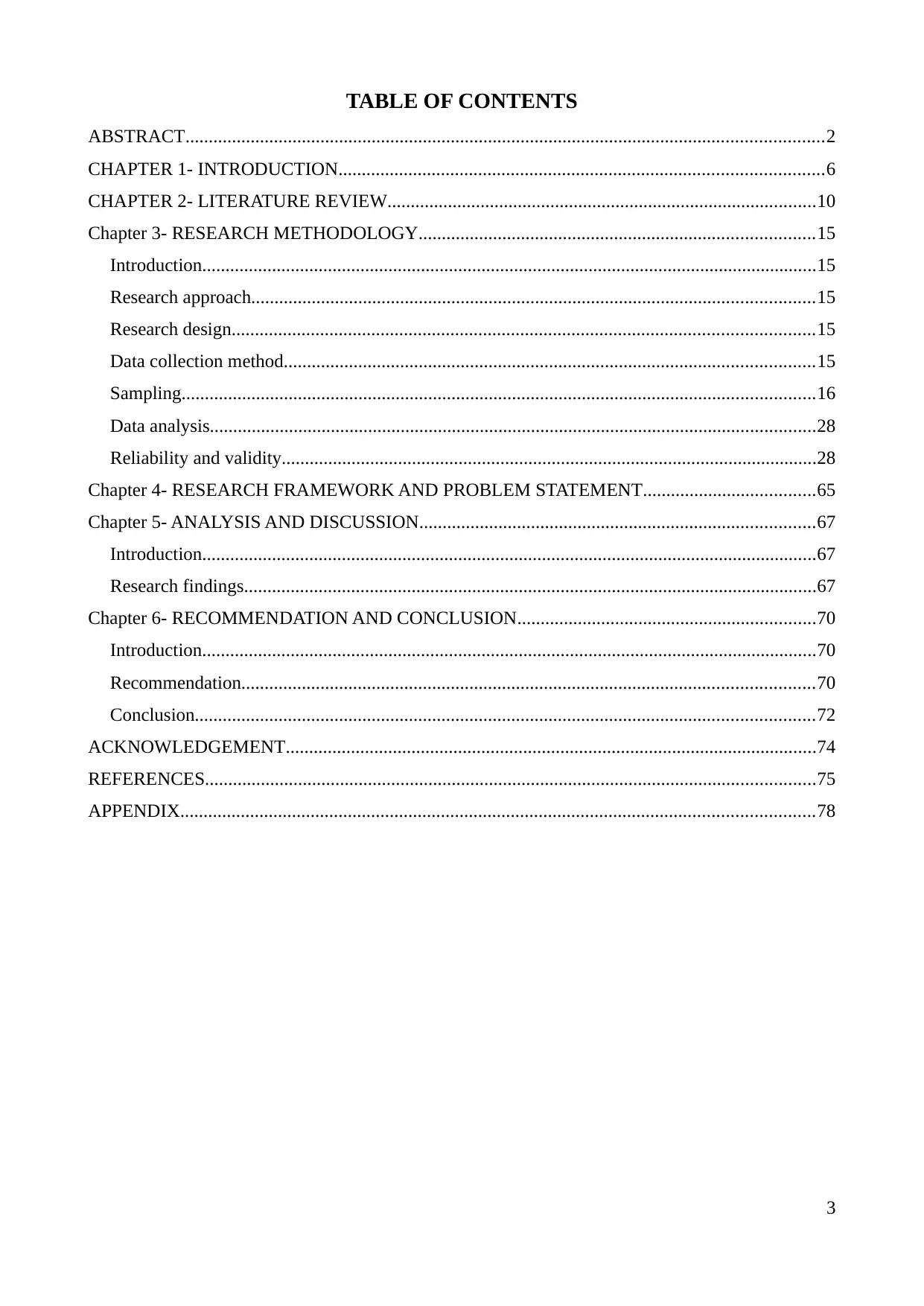
TABLE OF CONTENTS
ABSTRACT.........................................................................................................................................2
CHAPTER 1- INTRODUCTION........................................................................................................6
CHAPTER 2- LITERATURE REVIEW............................................................................................10
Chapter 3- RESEARCH METHODOLOGY.....................................................................................15
Introduction....................................................................................................................................15
Research approach.........................................................................................................................15
Research design.............................................................................................................................15
Data collection method..................................................................................................................15
Sampling........................................................................................................................................16
Data analysis..................................................................................................................................28
Reliability and validity...................................................................................................................28
Chapter 4- RESEARCH FRAMEWORK AND PROBLEM STATEMENT.....................................65
Chapter 5- ANALYSIS AND DISCUSSION.....................................................................................67
Introduction....................................................................................................................................67
Research findings...........................................................................................................................67
Chapter 6- RECOMMENDATION AND CONCLUSION................................................................70
Introduction....................................................................................................................................70
Recommendation...........................................................................................................................70
Conclusion.....................................................................................................................................72
ACKNOWLEDGEMENT..................................................................................................................74
REFERENCES...................................................................................................................................75
APPENDIX........................................................................................................................................78
3
ABSTRACT.........................................................................................................................................2
CHAPTER 1- INTRODUCTION........................................................................................................6
CHAPTER 2- LITERATURE REVIEW............................................................................................10
Chapter 3- RESEARCH METHODOLOGY.....................................................................................15
Introduction....................................................................................................................................15
Research approach.........................................................................................................................15
Research design.............................................................................................................................15
Data collection method..................................................................................................................15
Sampling........................................................................................................................................16
Data analysis..................................................................................................................................28
Reliability and validity...................................................................................................................28
Chapter 4- RESEARCH FRAMEWORK AND PROBLEM STATEMENT.....................................65
Chapter 5- ANALYSIS AND DISCUSSION.....................................................................................67
Introduction....................................................................................................................................67
Research findings...........................................................................................................................67
Chapter 6- RECOMMENDATION AND CONCLUSION................................................................70
Introduction....................................................................................................................................70
Recommendation...........................................................................................................................70
Conclusion.....................................................................................................................................72
ACKNOWLEDGEMENT..................................................................................................................74
REFERENCES...................................................................................................................................75
APPENDIX........................................................................................................................................78
3
⊘ This is a preview!⊘
Do you want full access?
Subscribe today to unlock all pages.

Trusted by 1+ million students worldwide
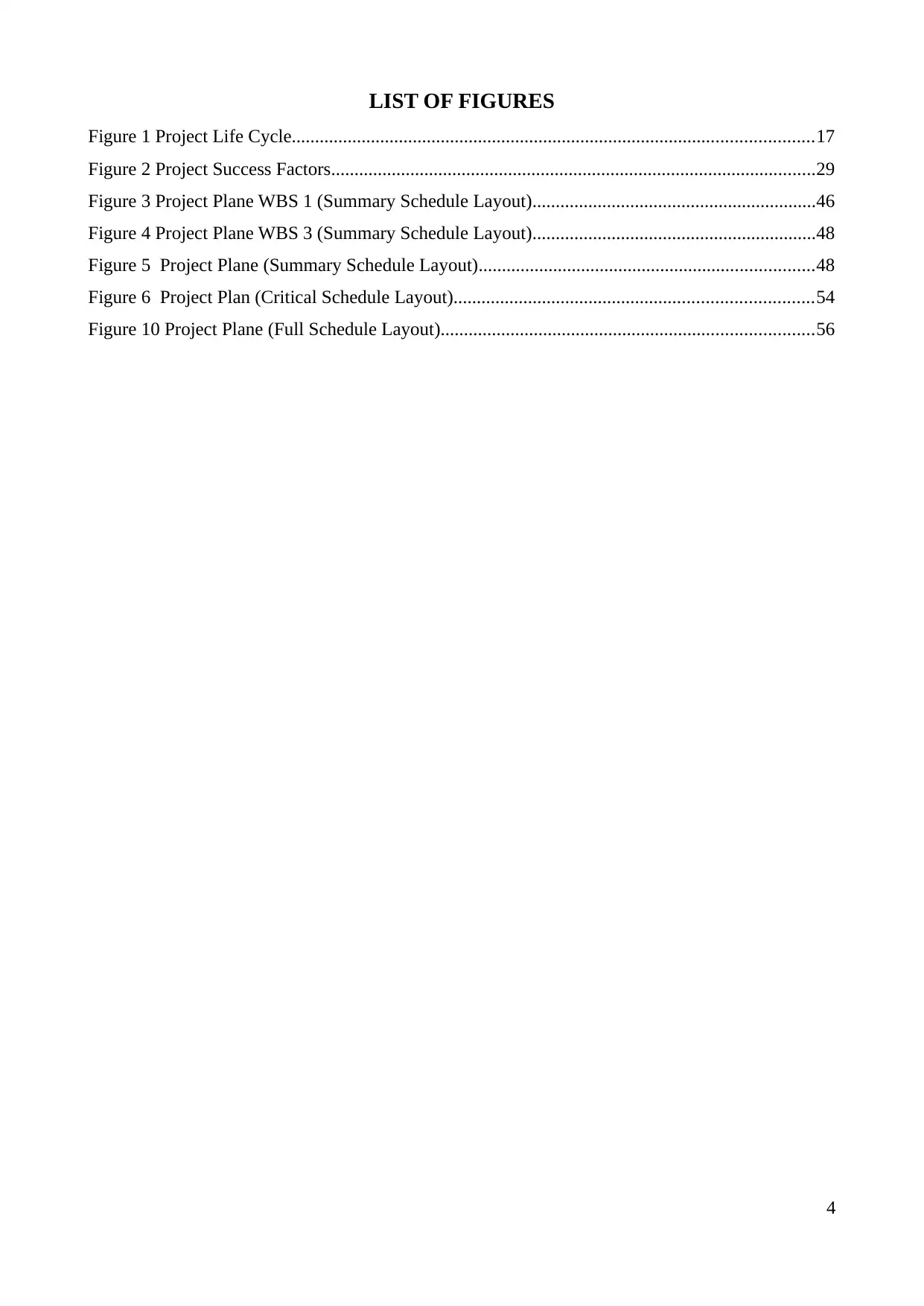
LIST OF FIGURES
Figure 1 Project Life Cycle................................................................................................................17
Figure 2 Project Success Factors........................................................................................................29
Figure 3 Project Plane WBS 1 (Summary Schedule Layout).............................................................46
Figure 4 Project Plane WBS 3 (Summary Schedule Layout).............................................................48
Figure 5 Project Plane (Summary Schedule Layout)........................................................................48
Figure 6 Project Plan (Critical Schedule Layout).............................................................................54
Figure 10 Project Plane (Full Schedule Layout)................................................................................56
4
Figure 1 Project Life Cycle................................................................................................................17
Figure 2 Project Success Factors........................................................................................................29
Figure 3 Project Plane WBS 1 (Summary Schedule Layout).............................................................46
Figure 4 Project Plane WBS 3 (Summary Schedule Layout).............................................................48
Figure 5 Project Plane (Summary Schedule Layout)........................................................................48
Figure 6 Project Plan (Critical Schedule Layout).............................................................................54
Figure 10 Project Plane (Full Schedule Layout)................................................................................56
4
Paraphrase This Document
Need a fresh take? Get an instant paraphrase of this document with our AI Paraphraser
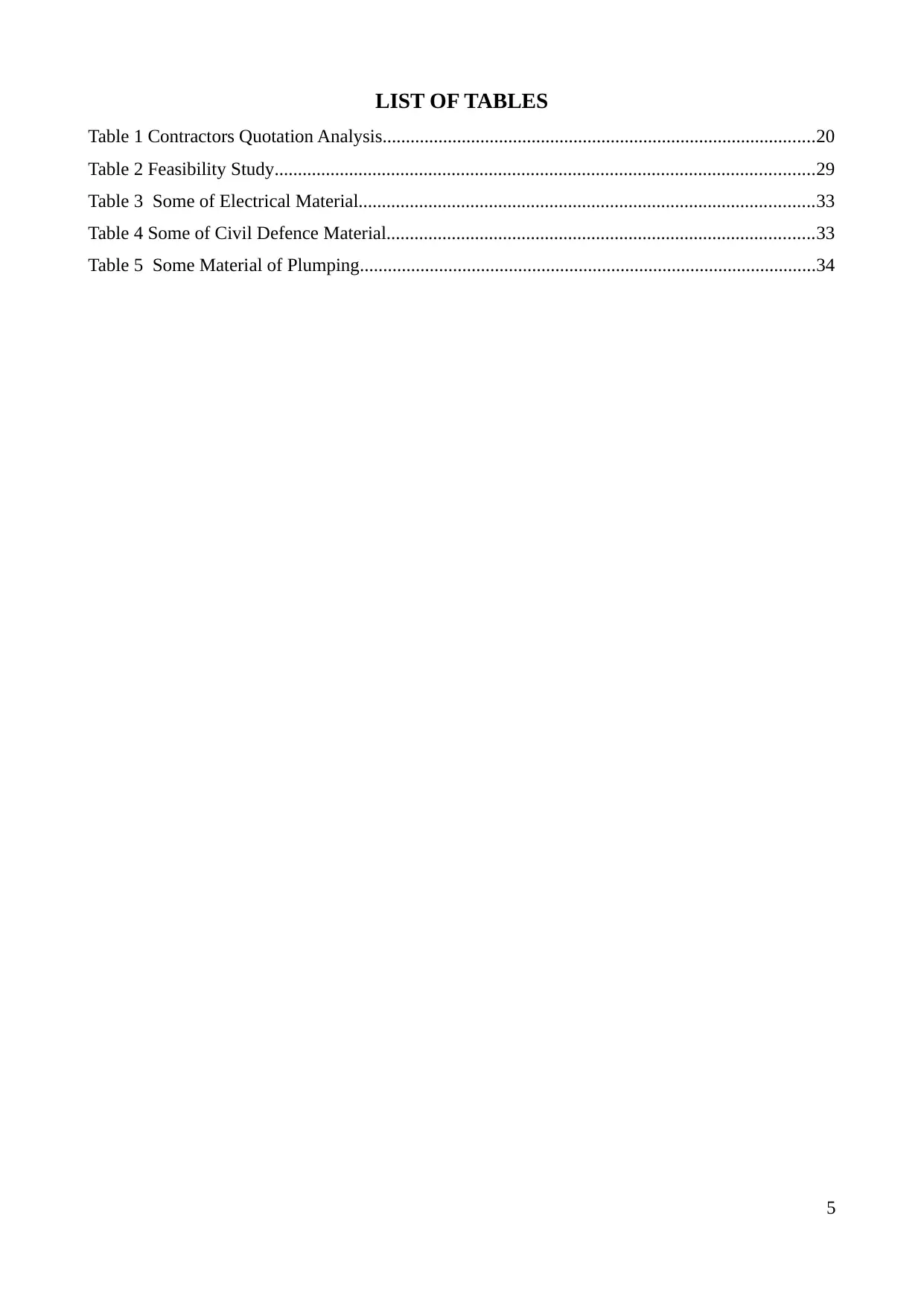
LIST OF TABLES
Table 1 Contractors Quotation Analysis.............................................................................................20
Table 2 Feasibility Study....................................................................................................................29
Table 3 Some of Electrical Material..................................................................................................33
Table 4 Some of Civil Defence Material............................................................................................33
Table 5 Some Material of Plumping..................................................................................................34
5
Table 1 Contractors Quotation Analysis.............................................................................................20
Table 2 Feasibility Study....................................................................................................................29
Table 3 Some of Electrical Material..................................................................................................33
Table 4 Some of Civil Defence Material............................................................................................33
Table 5 Some Material of Plumping..................................................................................................34
5
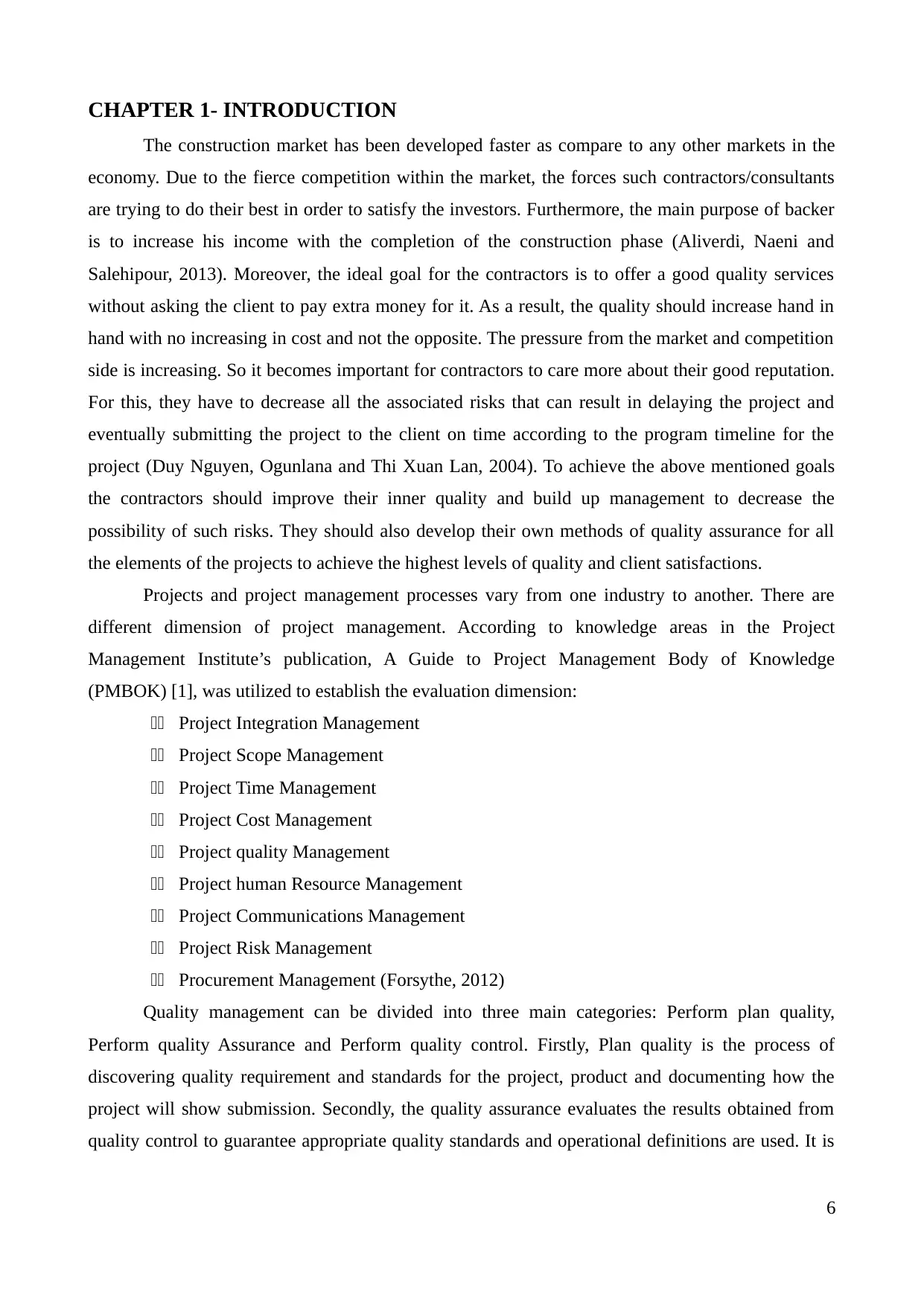
CHAPTER 1- INTRODUCTION
The construction market has been developed faster as compare to any other markets in the
economy. Due to the fierce competition within the market, the forces such contractors/consultants
are trying to do their best in order to satisfy the investors. Furthermore, the main purpose of backer
is to increase his income with the completion of the construction phase (Aliverdi, Naeni and
Salehipour, 2013). Moreover, the ideal goal for the contractors is to offer a good quality services
without asking the client to pay extra money for it. As a result, the quality should increase hand in
hand with no increasing in cost and not the opposite. The pressure from the market and competition
side is increasing. So it becomes important for contractors to care more about their good reputation.
For this, they have to decrease all the associated risks that can result in delaying the project and
eventually submitting the project to the client on time according to the program timeline for the
project (Duy Nguyen, Ogunlana and Thi Xuan Lan, 2004). To achieve the above mentioned goals
the contractors should improve their inner quality and build up management to decrease the
possibility of such risks. They should also develop their own methods of quality assurance for all
the elements of the projects to achieve the highest levels of quality and client satisfactions.
Projects and project management processes vary from one industry to another. There are
different dimension of project management. According to knowledge areas in the Project
Management Institute’s publication, A Guide to Project Management Body of Knowledge
(PMBOK) [1], was utilized to establish the evaluation dimension:
11 Project Integration Management
11 Project Scope Management
11 Project Time Management
11 Project Cost Management
11 Project quality Management
11 Project human Resource Management
11 Project Communications Management
11 Project Risk Management
11 Procurement Management (Forsythe, 2012)
Quality management can be divided into three main categories: Perform plan quality,
Perform quality Assurance and Perform quality control. Firstly, Plan quality is the process of
discovering quality requirement and standards for the project, product and documenting how the
project will show submission. Secondly, the quality assurance evaluates the results obtained from
quality control to guarantee appropriate quality standards and operational definitions are used. It is
6
The construction market has been developed faster as compare to any other markets in the
economy. Due to the fierce competition within the market, the forces such contractors/consultants
are trying to do their best in order to satisfy the investors. Furthermore, the main purpose of backer
is to increase his income with the completion of the construction phase (Aliverdi, Naeni and
Salehipour, 2013). Moreover, the ideal goal for the contractors is to offer a good quality services
without asking the client to pay extra money for it. As a result, the quality should increase hand in
hand with no increasing in cost and not the opposite. The pressure from the market and competition
side is increasing. So it becomes important for contractors to care more about their good reputation.
For this, they have to decrease all the associated risks that can result in delaying the project and
eventually submitting the project to the client on time according to the program timeline for the
project (Duy Nguyen, Ogunlana and Thi Xuan Lan, 2004). To achieve the above mentioned goals
the contractors should improve their inner quality and build up management to decrease the
possibility of such risks. They should also develop their own methods of quality assurance for all
the elements of the projects to achieve the highest levels of quality and client satisfactions.
Projects and project management processes vary from one industry to another. There are
different dimension of project management. According to knowledge areas in the Project
Management Institute’s publication, A Guide to Project Management Body of Knowledge
(PMBOK) [1], was utilized to establish the evaluation dimension:
11 Project Integration Management
11 Project Scope Management
11 Project Time Management
11 Project Cost Management
11 Project quality Management
11 Project human Resource Management
11 Project Communications Management
11 Project Risk Management
11 Procurement Management (Forsythe, 2012)
Quality management can be divided into three main categories: Perform plan quality,
Perform quality Assurance and Perform quality control. Firstly, Plan quality is the process of
discovering quality requirement and standards for the project, product and documenting how the
project will show submission. Secondly, the quality assurance evaluates the results obtained from
quality control to guarantee appropriate quality standards and operational definitions are used. It is
6
⊘ This is a preview!⊘
Do you want full access?
Subscribe today to unlock all pages.

Trusted by 1+ million students worldwide
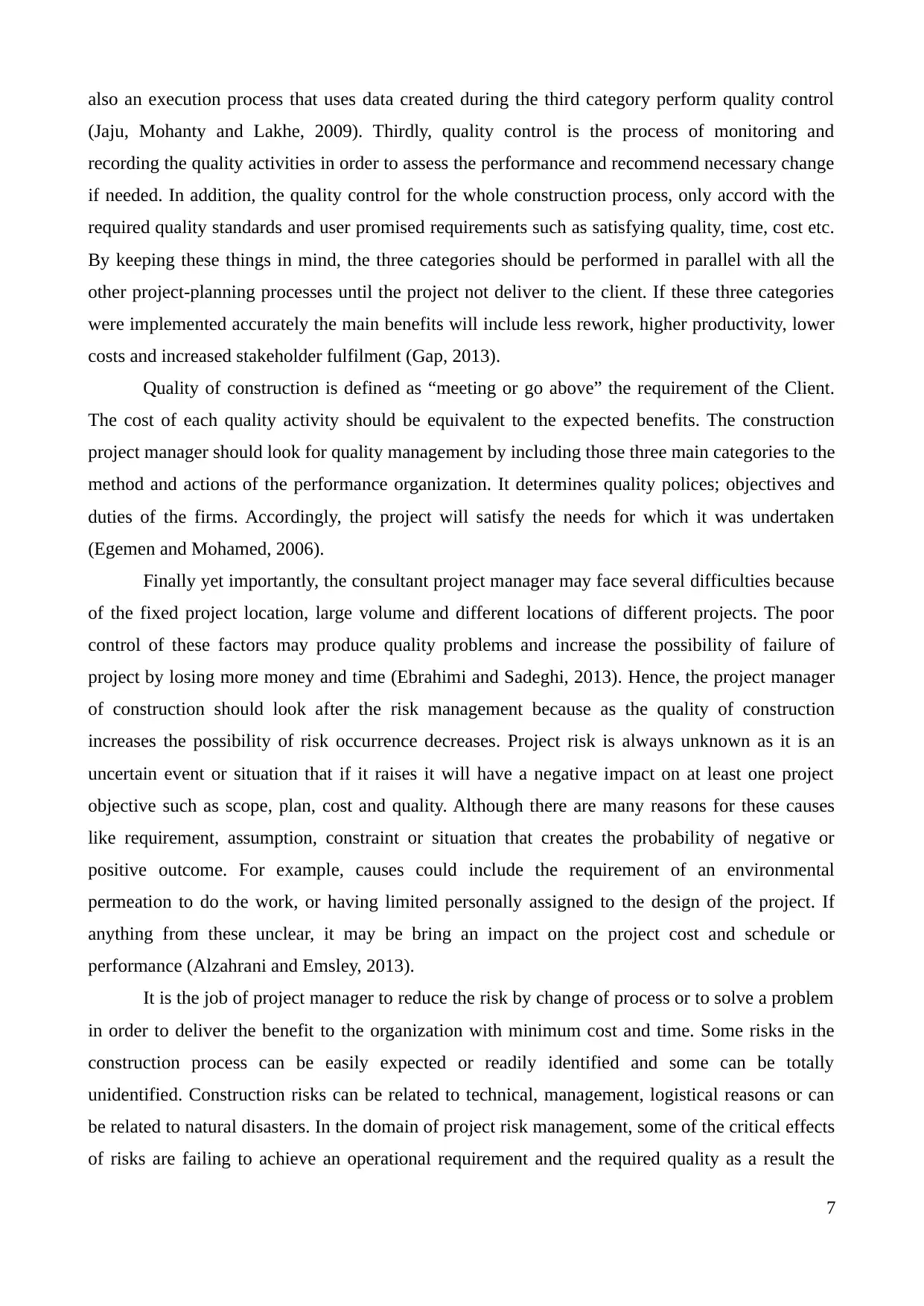
also an execution process that uses data created during the third category perform quality control
(Jaju, Mohanty and Lakhe, 2009). Thirdly, quality control is the process of monitoring and
recording the quality activities in order to assess the performance and recommend necessary change
if needed. In addition, the quality control for the whole construction process, only accord with the
required quality standards and user promised requirements such as satisfying quality, time, cost etc.
By keeping these things in mind, the three categories should be performed in parallel with all the
other project-planning processes until the project not deliver to the client. If these three categories
were implemented accurately the main benefits will include less rework, higher productivity, lower
costs and increased stakeholder fulfilment (Gap, 2013).
Quality of construction is defined as “meeting or go above” the requirement of the Client.
The cost of each quality activity should be equivalent to the expected benefits. The construction
project manager should look for quality management by including those three main categories to the
method and actions of the performance organization. It determines quality polices; objectives and
duties of the firms. Accordingly, the project will satisfy the needs for which it was undertaken
(Egemen and Mohamed, 2006).
Finally yet importantly, the consultant project manager may face several difficulties because
of the fixed project location, large volume and different locations of different projects. The poor
control of these factors may produce quality problems and increase the possibility of failure of
project by losing more money and time (Ebrahimi and Sadeghi, 2013). Hence, the project manager
of construction should look after the risk management because as the quality of construction
increases the possibility of risk occurrence decreases. Project risk is always unknown as it is an
uncertain event or situation that if it raises it will have a negative impact on at least one project
objective such as scope, plan, cost and quality. Although there are many reasons for these causes
like requirement, assumption, constraint or situation that creates the probability of negative or
positive outcome. For example, causes could include the requirement of an environmental
permeation to do the work, or having limited personally assigned to the design of the project. If
anything from these unclear, it may be bring an impact on the project cost and schedule or
performance (Alzahrani and Emsley, 2013).
It is the job of project manager to reduce the risk by change of process or to solve a problem
in order to deliver the benefit to the organization with minimum cost and time. Some risks in the
construction process can be easily expected or readily identified and some can be totally
unidentified. Construction risks can be related to technical, management, logistical reasons or can
be related to natural disasters. In the domain of project risk management, some of the critical effects
of risks are failing to achieve an operational requirement and the required quality as a result the
7
(Jaju, Mohanty and Lakhe, 2009). Thirdly, quality control is the process of monitoring and
recording the quality activities in order to assess the performance and recommend necessary change
if needed. In addition, the quality control for the whole construction process, only accord with the
required quality standards and user promised requirements such as satisfying quality, time, cost etc.
By keeping these things in mind, the three categories should be performed in parallel with all the
other project-planning processes until the project not deliver to the client. If these three categories
were implemented accurately the main benefits will include less rework, higher productivity, lower
costs and increased stakeholder fulfilment (Gap, 2013).
Quality of construction is defined as “meeting or go above” the requirement of the Client.
The cost of each quality activity should be equivalent to the expected benefits. The construction
project manager should look for quality management by including those three main categories to the
method and actions of the performance organization. It determines quality polices; objectives and
duties of the firms. Accordingly, the project will satisfy the needs for which it was undertaken
(Egemen and Mohamed, 2006).
Finally yet importantly, the consultant project manager may face several difficulties because
of the fixed project location, large volume and different locations of different projects. The poor
control of these factors may produce quality problems and increase the possibility of failure of
project by losing more money and time (Ebrahimi and Sadeghi, 2013). Hence, the project manager
of construction should look after the risk management because as the quality of construction
increases the possibility of risk occurrence decreases. Project risk is always unknown as it is an
uncertain event or situation that if it raises it will have a negative impact on at least one project
objective such as scope, plan, cost and quality. Although there are many reasons for these causes
like requirement, assumption, constraint or situation that creates the probability of negative or
positive outcome. For example, causes could include the requirement of an environmental
permeation to do the work, or having limited personally assigned to the design of the project. If
anything from these unclear, it may be bring an impact on the project cost and schedule or
performance (Alzahrani and Emsley, 2013).
It is the job of project manager to reduce the risk by change of process or to solve a problem
in order to deliver the benefit to the organization with minimum cost and time. Some risks in the
construction process can be easily expected or readily identified and some can be totally
unidentified. Construction risks can be related to technical, management, logistical reasons or can
be related to natural disasters. In the domain of project risk management, some of the critical effects
of risks are failing to achieve an operational requirement and the required quality as a result the
7
Paraphrase This Document
Need a fresh take? Get an instant paraphrase of this document with our AI Paraphraser
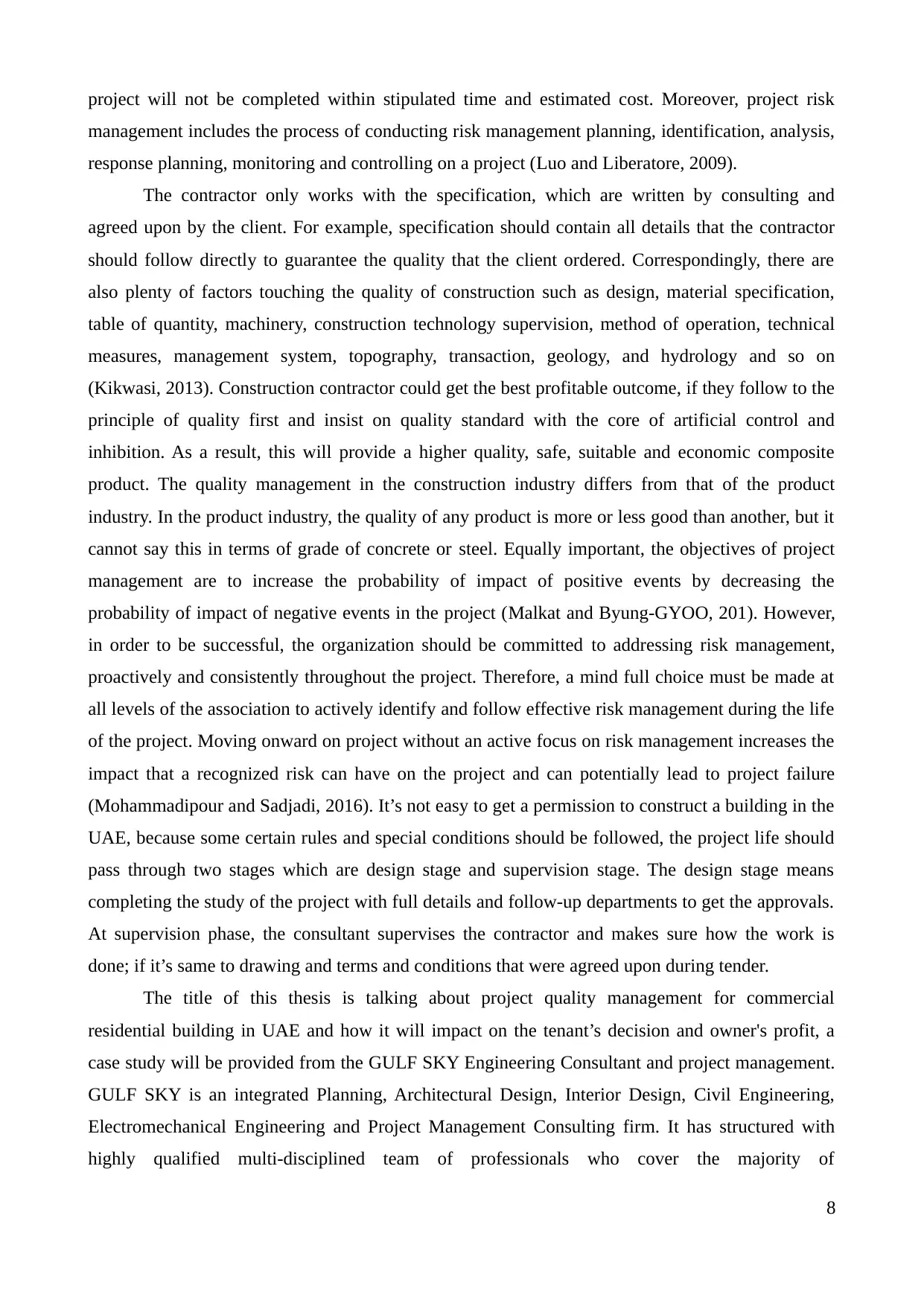
project will not be completed within stipulated time and estimated cost. Moreover, project risk
management includes the process of conducting risk management planning, identification, analysis,
response planning, monitoring and controlling on a project (Luo and Liberatore, 2009).
The contractor only works with the specification, which are written by consulting and
agreed upon by the client. For example, specification should contain all details that the contractor
should follow directly to guarantee the quality that the client ordered. Correspondingly, there are
also plenty of factors touching the quality of construction such as design, material specification,
table of quantity, machinery, construction technology supervision, method of operation, technical
measures, management system, topography, transaction, geology, and hydrology and so on
(Kikwasi, 2013). Construction contractor could get the best profitable outcome, if they follow to the
principle of quality first and insist on quality standard with the core of artificial control and
inhibition. As a result, this will provide a higher quality, safe, suitable and economic composite
product. The quality management in the construction industry differs from that of the product
industry. In the product industry, the quality of any product is more or less good than another, but it
cannot say this in terms of grade of concrete or steel. Equally important, the objectives of project
management are to increase the probability of impact of positive events by decreasing the
probability of impact of negative events in the project (Malkat and Byung-GYOO, 201). However,
in order to be successful, the organization should be committed to addressing risk management,
proactively and consistently throughout the project. Therefore, a mind full choice must be made at
all levels of the association to actively identify and follow effective risk management during the life
of the project. Moving onward on project without an active focus on risk management increases the
impact that a recognized risk can have on the project and can potentially lead to project failure
(Mohammadipour and Sadjadi, 2016). It’s not easy to get a permission to construct a building in the
UAE, because some certain rules and special conditions should be followed, the project life should
pass through two stages which are design stage and supervision stage. The design stage means
completing the study of the project with full details and follow-up departments to get the approvals.
At supervision phase, the consultant supervises the contractor and makes sure how the work is
done; if it’s same to drawing and terms and conditions that were agreed upon during tender.
The title of this thesis is talking about project quality management for commercial
residential building in UAE and how it will impact on the tenant’s decision and owner's profit, a
case study will be provided from the GULF SKY Engineering Consultant and project management.
GULF SKY is an integrated Planning, Architectural Design, Interior Design, Civil Engineering,
Electromechanical Engineering and Project Management Consulting firm. It has structured with
highly qualified multi-disciplined team of professionals who cover the majority of
8
management includes the process of conducting risk management planning, identification, analysis,
response planning, monitoring and controlling on a project (Luo and Liberatore, 2009).
The contractor only works with the specification, which are written by consulting and
agreed upon by the client. For example, specification should contain all details that the contractor
should follow directly to guarantee the quality that the client ordered. Correspondingly, there are
also plenty of factors touching the quality of construction such as design, material specification,
table of quantity, machinery, construction technology supervision, method of operation, technical
measures, management system, topography, transaction, geology, and hydrology and so on
(Kikwasi, 2013). Construction contractor could get the best profitable outcome, if they follow to the
principle of quality first and insist on quality standard with the core of artificial control and
inhibition. As a result, this will provide a higher quality, safe, suitable and economic composite
product. The quality management in the construction industry differs from that of the product
industry. In the product industry, the quality of any product is more or less good than another, but it
cannot say this in terms of grade of concrete or steel. Equally important, the objectives of project
management are to increase the probability of impact of positive events by decreasing the
probability of impact of negative events in the project (Malkat and Byung-GYOO, 201). However,
in order to be successful, the organization should be committed to addressing risk management,
proactively and consistently throughout the project. Therefore, a mind full choice must be made at
all levels of the association to actively identify and follow effective risk management during the life
of the project. Moving onward on project without an active focus on risk management increases the
impact that a recognized risk can have on the project and can potentially lead to project failure
(Mohammadipour and Sadjadi, 2016). It’s not easy to get a permission to construct a building in the
UAE, because some certain rules and special conditions should be followed, the project life should
pass through two stages which are design stage and supervision stage. The design stage means
completing the study of the project with full details and follow-up departments to get the approvals.
At supervision phase, the consultant supervises the contractor and makes sure how the work is
done; if it’s same to drawing and terms and conditions that were agreed upon during tender.
The title of this thesis is talking about project quality management for commercial
residential building in UAE and how it will impact on the tenant’s decision and owner's profit, a
case study will be provided from the GULF SKY Engineering Consultant and project management.
GULF SKY is an integrated Planning, Architectural Design, Interior Design, Civil Engineering,
Electromechanical Engineering and Project Management Consulting firm. It has structured with
highly qualified multi-disciplined team of professionals who cover the majority of
8
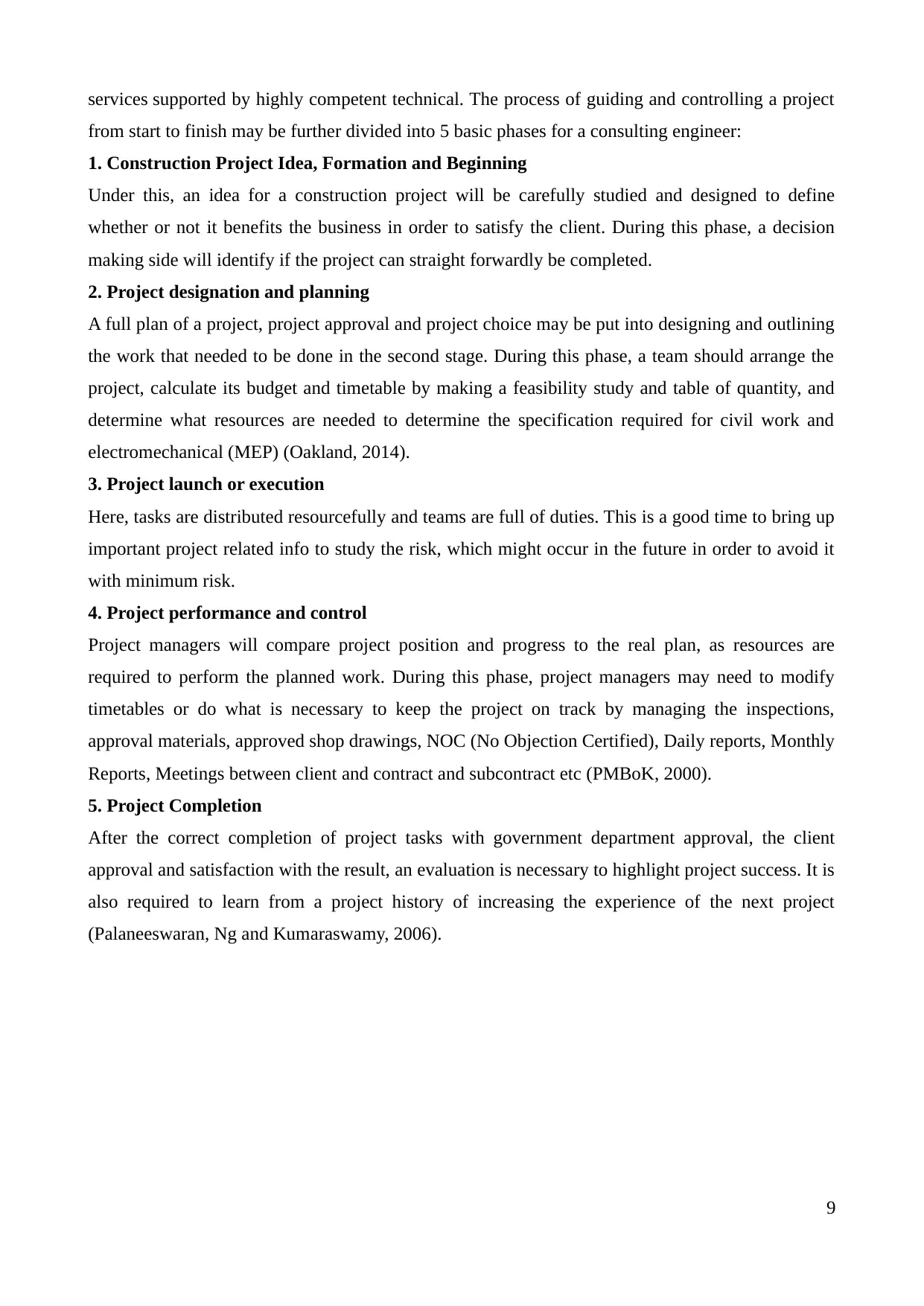
services supported by highly competent technical. The process of guiding and controlling a project
from start to finish may be further divided into 5 basic phases for a consulting engineer:
1. Construction Project Idea, Formation and Beginning
Under this, an idea for a construction project will be carefully studied and designed to define
whether or not it benefits the business in order to satisfy the client. During this phase, a decision
making side will identify if the project can straight forwardly be completed.
2. Project designation and planning
A full plan of a project, project approval and project choice may be put into designing and outlining
the work that needed to be done in the second stage. During this phase, a team should arrange the
project, calculate its budget and timetable by making a feasibility study and table of quantity, and
determine what resources are needed to determine the specification required for civil work and
electromechanical (MEP) (Oakland, 2014).
3. Project launch or execution
Here, tasks are distributed resourcefully and teams are full of duties. This is a good time to bring up
important project related info to study the risk, which might occur in the future in order to avoid it
with minimum risk.
4. Project performance and control
Project managers will compare project position and progress to the real plan, as resources are
required to perform the planned work. During this phase, project managers may need to modify
timetables or do what is necessary to keep the project on track by managing the inspections,
approval materials, approved shop drawings, NOC (No Objection Certified), Daily reports, Monthly
Reports, Meetings between client and contract and subcontract etc (PMBoK, 2000).
5. Project Completion
After the correct completion of project tasks with government department approval, the client
approval and satisfaction with the result, an evaluation is necessary to highlight project success. It is
also required to learn from a project history of increasing the experience of the next project
(Palaneeswaran, Ng and Kumaraswamy, 2006).
9
from start to finish may be further divided into 5 basic phases for a consulting engineer:
1. Construction Project Idea, Formation and Beginning
Under this, an idea for a construction project will be carefully studied and designed to define
whether or not it benefits the business in order to satisfy the client. During this phase, a decision
making side will identify if the project can straight forwardly be completed.
2. Project designation and planning
A full plan of a project, project approval and project choice may be put into designing and outlining
the work that needed to be done in the second stage. During this phase, a team should arrange the
project, calculate its budget and timetable by making a feasibility study and table of quantity, and
determine what resources are needed to determine the specification required for civil work and
electromechanical (MEP) (Oakland, 2014).
3. Project launch or execution
Here, tasks are distributed resourcefully and teams are full of duties. This is a good time to bring up
important project related info to study the risk, which might occur in the future in order to avoid it
with minimum risk.
4. Project performance and control
Project managers will compare project position and progress to the real plan, as resources are
required to perform the planned work. During this phase, project managers may need to modify
timetables or do what is necessary to keep the project on track by managing the inspections,
approval materials, approved shop drawings, NOC (No Objection Certified), Daily reports, Monthly
Reports, Meetings between client and contract and subcontract etc (PMBoK, 2000).
5. Project Completion
After the correct completion of project tasks with government department approval, the client
approval and satisfaction with the result, an evaluation is necessary to highlight project success. It is
also required to learn from a project history of increasing the experience of the next project
(Palaneeswaran, Ng and Kumaraswamy, 2006).
9
⊘ This is a preview!⊘
Do you want full access?
Subscribe today to unlock all pages.

Trusted by 1+ million students worldwide
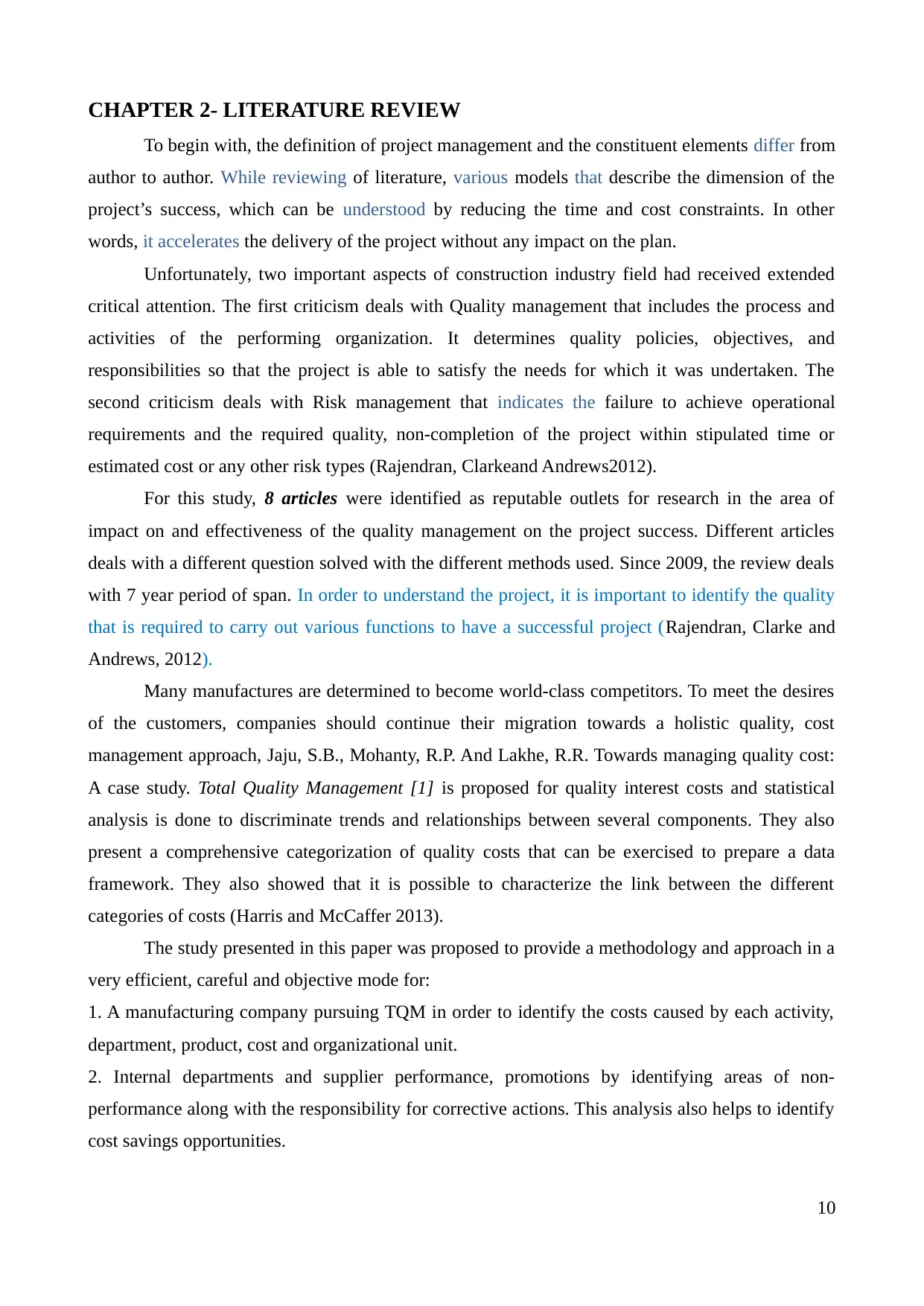
CHAPTER 2- LITERATURE REVIEW
To begin with, the definition of project management and the constituent elements differ from
author to author. While reviewing of literature, various models that describe the dimension of the
project’s success, which can be understood by reducing the time and cost constraints. In other
words, it accelerates the delivery of the project without any impact on the plan.
Unfortunately, two important aspects of construction industry field had received extended
critical attention. The first criticism deals with Quality management that includes the process and
activities of the performing organization. It determines quality policies, objectives, and
responsibilities so that the project is able to satisfy the needs for which it was undertaken. The
second criticism deals with Risk management that indicates the failure to achieve operational
requirements and the required quality, non-completion of the project within stipulated time or
estimated cost or any other risk types (Rajendran, Clarkeand Andrews2012).
For this study, 8 articles were identified as reputable outlets for research in the area of
impact on and effectiveness of the quality management on the project success. Different articles
deals with a different question solved with the different methods used. Since 2009, the review deals
with 7 year period of span. In order to understand the project, it is important to identify the quality
that is required to carry out various functions to have a successful project (Rajendran, Clarke and
Andrews, 2012).
Many manufactures are determined to become world-class competitors. To meet the desires
of the customers, companies should continue their migration towards a holistic quality, cost
management approach, Jaju, S.B., Mohanty, R.P. And Lakhe, R.R. Towards managing quality cost:
A case study. Total Quality Management [1] is proposed for quality interest costs and statistical
analysis is done to discriminate trends and relationships between several components. They also
present a comprehensive categorization of quality costs that can be exercised to prepare a data
framework. They also showed that it is possible to characterize the link between the different
categories of costs (Harris and McCaffer 2013).
The study presented in this paper was proposed to provide a methodology and approach in a
very efficient, careful and objective mode for:
1. A manufacturing company pursuing TQM in order to identify the costs caused by each activity,
department, product, cost and organizational unit.
2. Internal departments and supplier performance, promotions by identifying areas of non-
performance along with the responsibility for corrective actions. This analysis also helps to identify
cost savings opportunities.
10
To begin with, the definition of project management and the constituent elements differ from
author to author. While reviewing of literature, various models that describe the dimension of the
project’s success, which can be understood by reducing the time and cost constraints. In other
words, it accelerates the delivery of the project without any impact on the plan.
Unfortunately, two important aspects of construction industry field had received extended
critical attention. The first criticism deals with Quality management that includes the process and
activities of the performing organization. It determines quality policies, objectives, and
responsibilities so that the project is able to satisfy the needs for which it was undertaken. The
second criticism deals with Risk management that indicates the failure to achieve operational
requirements and the required quality, non-completion of the project within stipulated time or
estimated cost or any other risk types (Rajendran, Clarkeand Andrews2012).
For this study, 8 articles were identified as reputable outlets for research in the area of
impact on and effectiveness of the quality management on the project success. Different articles
deals with a different question solved with the different methods used. Since 2009, the review deals
with 7 year period of span. In order to understand the project, it is important to identify the quality
that is required to carry out various functions to have a successful project (Rajendran, Clarke and
Andrews, 2012).
Many manufactures are determined to become world-class competitors. To meet the desires
of the customers, companies should continue their migration towards a holistic quality, cost
management approach, Jaju, S.B., Mohanty, R.P. And Lakhe, R.R. Towards managing quality cost:
A case study. Total Quality Management [1] is proposed for quality interest costs and statistical
analysis is done to discriminate trends and relationships between several components. They also
present a comprehensive categorization of quality costs that can be exercised to prepare a data
framework. They also showed that it is possible to characterize the link between the different
categories of costs (Harris and McCaffer 2013).
The study presented in this paper was proposed to provide a methodology and approach in a
very efficient, careful and objective mode for:
1. A manufacturing company pursuing TQM in order to identify the costs caused by each activity,
department, product, cost and organizational unit.
2. Internal departments and supplier performance, promotions by identifying areas of non-
performance along with the responsibility for corrective actions. This analysis also helps to identify
cost savings opportunities.
10
Paraphrase This Document
Need a fresh take? Get an instant paraphrase of this document with our AI Paraphraser
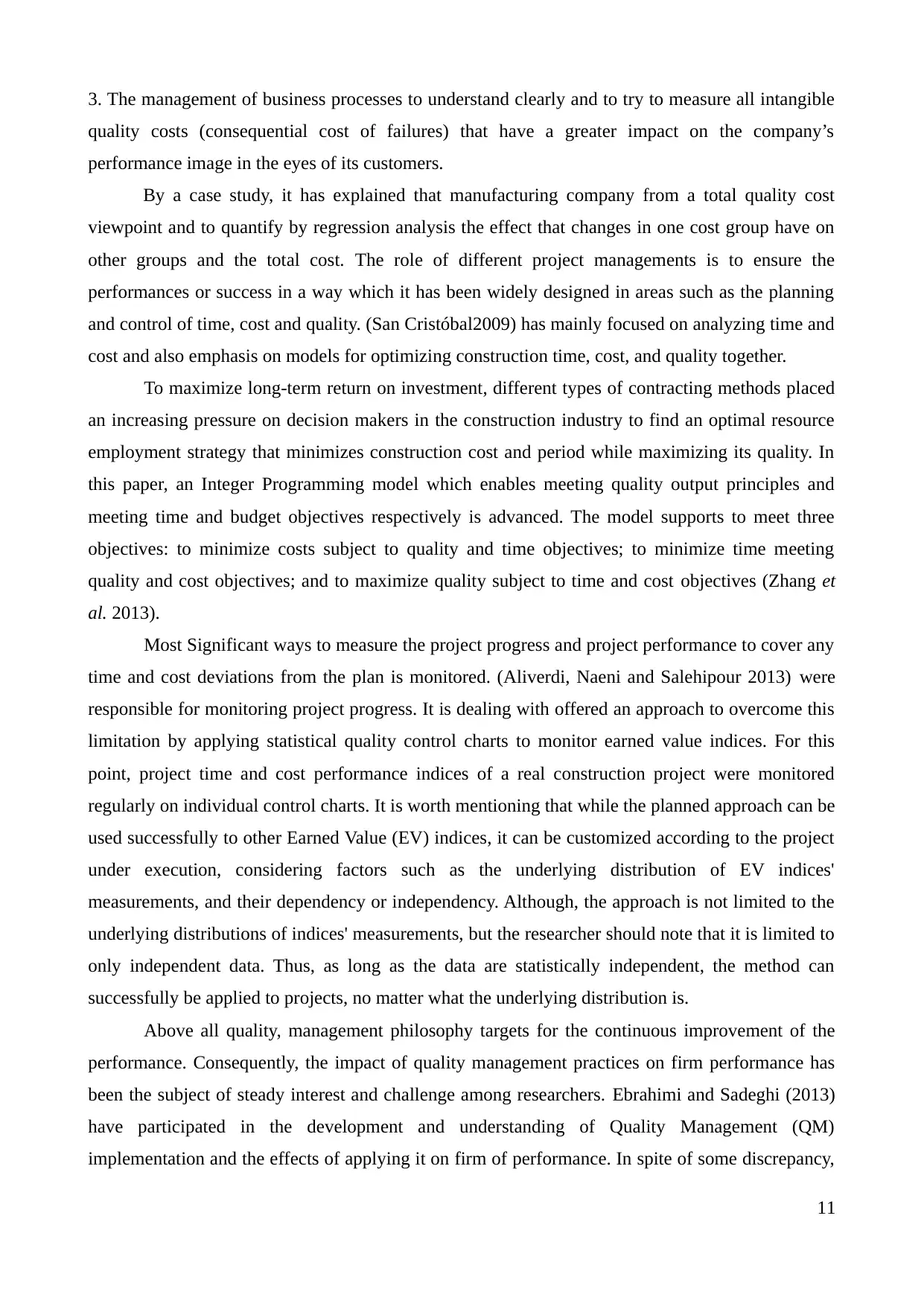
3. The management of business processes to understand clearly and to try to measure all intangible
quality costs (consequential cost of failures) that have a greater impact on the company’s
performance image in the eyes of its customers.
By a case study, it has explained that manufacturing company from a total quality cost
viewpoint and to quantify by regression analysis the effect that changes in one cost group have on
other groups and the total cost. The role of different project managements is to ensure the
performances or success in a way which it has been widely designed in areas such as the planning
and control of time, cost and quality. (San Cristóbal2009) has mainly focused on analyzing time and
cost and also emphasis on models for optimizing construction time, cost, and quality together.
To maximize long-term return on investment, different types of contracting methods placed
an increasing pressure on decision makers in the construction industry to find an optimal resource
employment strategy that minimizes construction cost and period while maximizing its quality. In
this paper, an Integer Programming model which enables meeting quality output principles and
meeting time and budget objectives respectively is advanced. The model supports to meet three
objectives: to minimize costs subject to quality and time objectives; to minimize time meeting
quality and cost objectives; and to maximize quality subject to time and cost objectives (Zhang et
al. 2013).
Most Significant ways to measure the project progress and project performance to cover any
time and cost deviations from the plan is monitored. (Aliverdi, Naeni and Salehipour 2013) were
responsible for monitoring project progress. It is dealing with offered an approach to overcome this
limitation by applying statistical quality control charts to monitor earned value indices. For this
point, project time and cost performance indices of a real construction project were monitored
regularly on individual control charts. It is worth mentioning that while the planned approach can be
used successfully to other Earned Value (EV) indices, it can be customized according to the project
under execution, considering factors such as the underlying distribution of EV indices'
measurements, and their dependency or independency. Although, the approach is not limited to the
underlying distributions of indices' measurements, but the researcher should note that it is limited to
only independent data. Thus, as long as the data are statistically independent, the method can
successfully be applied to projects, no matter what the underlying distribution is.
Above all quality, management philosophy targets for the continuous improvement of the
performance. Consequently, the impact of quality management practices on firm performance has
been the subject of steady interest and challenge among researchers. Ebrahimi and Sadeghi (2013)
have participated in the development and understanding of Quality Management (QM)
implementation and the effects of applying it on firm of performance. In spite of some discrepancy,
11
quality costs (consequential cost of failures) that have a greater impact on the company’s
performance image in the eyes of its customers.
By a case study, it has explained that manufacturing company from a total quality cost
viewpoint and to quantify by regression analysis the effect that changes in one cost group have on
other groups and the total cost. The role of different project managements is to ensure the
performances or success in a way which it has been widely designed in areas such as the planning
and control of time, cost and quality. (San Cristóbal2009) has mainly focused on analyzing time and
cost and also emphasis on models for optimizing construction time, cost, and quality together.
To maximize long-term return on investment, different types of contracting methods placed
an increasing pressure on decision makers in the construction industry to find an optimal resource
employment strategy that minimizes construction cost and period while maximizing its quality. In
this paper, an Integer Programming model which enables meeting quality output principles and
meeting time and budget objectives respectively is advanced. The model supports to meet three
objectives: to minimize costs subject to quality and time objectives; to minimize time meeting
quality and cost objectives; and to maximize quality subject to time and cost objectives (Zhang et
al. 2013).
Most Significant ways to measure the project progress and project performance to cover any
time and cost deviations from the plan is monitored. (Aliverdi, Naeni and Salehipour 2013) were
responsible for monitoring project progress. It is dealing with offered an approach to overcome this
limitation by applying statistical quality control charts to monitor earned value indices. For this
point, project time and cost performance indices of a real construction project were monitored
regularly on individual control charts. It is worth mentioning that while the planned approach can be
used successfully to other Earned Value (EV) indices, it can be customized according to the project
under execution, considering factors such as the underlying distribution of EV indices'
measurements, and their dependency or independency. Although, the approach is not limited to the
underlying distributions of indices' measurements, but the researcher should note that it is limited to
only independent data. Thus, as long as the data are statistically independent, the method can
successfully be applied to projects, no matter what the underlying distribution is.
Above all quality, management philosophy targets for the continuous improvement of the
performance. Consequently, the impact of quality management practices on firm performance has
been the subject of steady interest and challenge among researchers. Ebrahimi and Sadeghi (2013)
have participated in the development and understanding of Quality Management (QM)
implementation and the effects of applying it on firm of performance. In spite of some discrepancy,
11
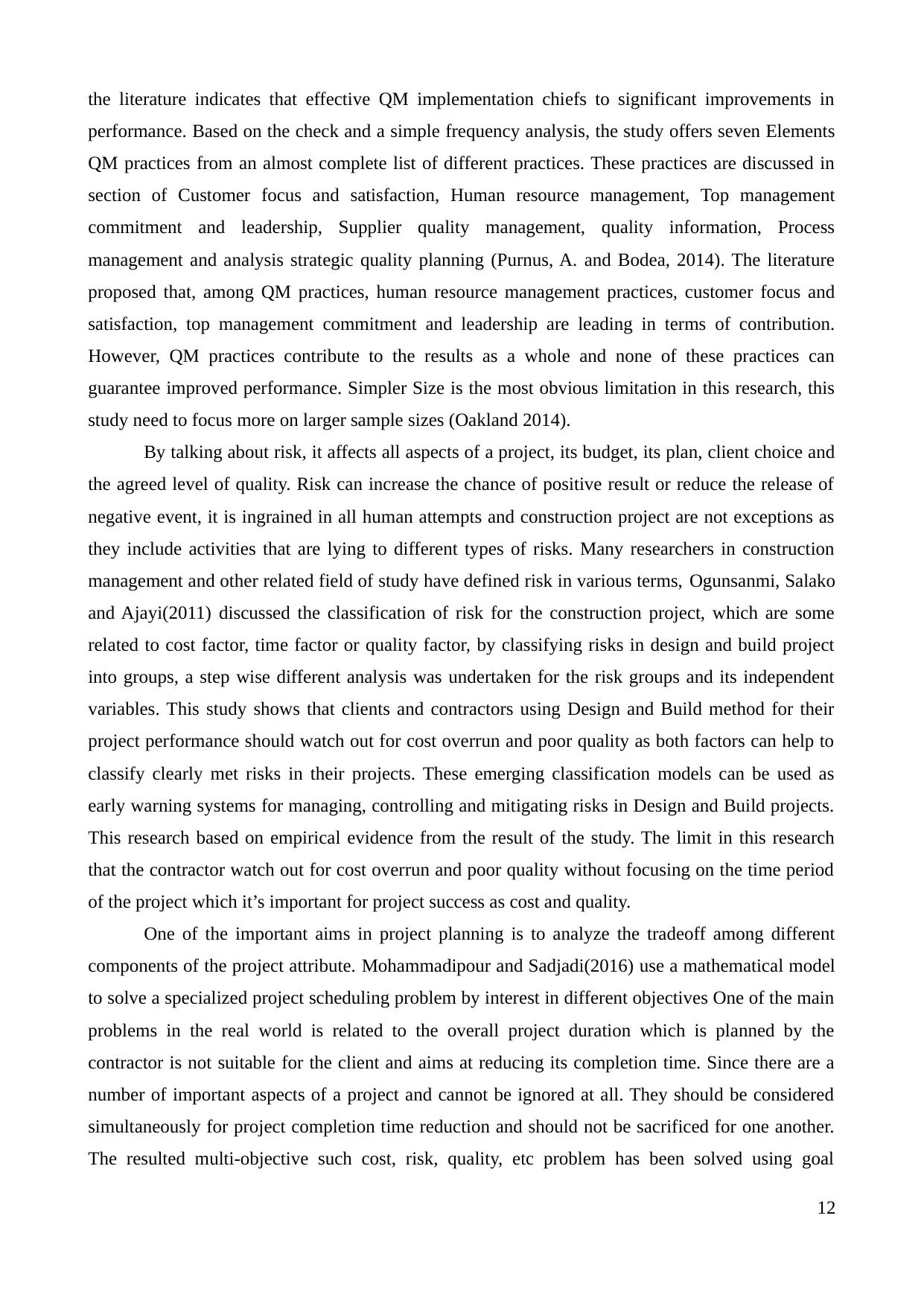
the literature indicates that effective QM implementation chiefs to significant improvements in
performance. Based on the check and a simple frequency analysis, the study offers seven Elements
QM practices from an almost complete list of different practices. These practices are discussed in
section of Customer focus and satisfaction, Human resource management, Top management
commitment and leadership, Supplier quality management, quality information, Process
management and analysis strategic quality planning (Purnus, A. and Bodea, 2014). The literature
proposed that, among QM practices, human resource management practices, customer focus and
satisfaction, top management commitment and leadership are leading in terms of contribution.
However, QM practices contribute to the results as a whole and none of these practices can
guarantee improved performance. Simpler Size is the most obvious limitation in this research, this
study need to focus more on larger sample sizes (Oakland 2014).
By talking about risk, it affects all aspects of a project, its budget, its plan, client choice and
the agreed level of quality. Risk can increase the chance of positive result or reduce the release of
negative event, it is ingrained in all human attempts and construction project are not exceptions as
they include activities that are lying to different types of risks. Many researchers in construction
management and other related field of study have defined risk in various terms, Ogunsanmi, Salako
and Ajayi(2011) discussed the classification of risk for the construction project, which are some
related to cost factor, time factor or quality factor, by classifying risks in design and build project
into groups, a step wise different analysis was undertaken for the risk groups and its independent
variables. This study shows that clients and contractors using Design and Build method for their
project performance should watch out for cost overrun and poor quality as both factors can help to
classify clearly met risks in their projects. These emerging classification models can be used as
early warning systems for managing, controlling and mitigating risks in Design and Build projects.
This research based on empirical evidence from the result of the study. The limit in this research
that the contractor watch out for cost overrun and poor quality without focusing on the time period
of the project which it’s important for project success as cost and quality.
One of the important aims in project planning is to analyze the tradeoff among different
components of the project attribute. Mohammadipour and Sadjadi(2016) use a mathematical model
to solve a specialized project scheduling problem by interest in different objectives One of the main
problems in the real world is related to the overall project duration which is planned by the
contractor is not suitable for the client and aims at reducing its completion time. Since there are a
number of important aspects of a project and cannot be ignored at all. They should be considered
simultaneously for project completion time reduction and should not be sacrificed for one another.
The resulted multi-objective such cost, risk, quality, etc problem has been solved using goal
12
performance. Based on the check and a simple frequency analysis, the study offers seven Elements
QM practices from an almost complete list of different practices. These practices are discussed in
section of Customer focus and satisfaction, Human resource management, Top management
commitment and leadership, Supplier quality management, quality information, Process
management and analysis strategic quality planning (Purnus, A. and Bodea, 2014). The literature
proposed that, among QM practices, human resource management practices, customer focus and
satisfaction, top management commitment and leadership are leading in terms of contribution.
However, QM practices contribute to the results as a whole and none of these practices can
guarantee improved performance. Simpler Size is the most obvious limitation in this research, this
study need to focus more on larger sample sizes (Oakland 2014).
By talking about risk, it affects all aspects of a project, its budget, its plan, client choice and
the agreed level of quality. Risk can increase the chance of positive result or reduce the release of
negative event, it is ingrained in all human attempts and construction project are not exceptions as
they include activities that are lying to different types of risks. Many researchers in construction
management and other related field of study have defined risk in various terms, Ogunsanmi, Salako
and Ajayi(2011) discussed the classification of risk for the construction project, which are some
related to cost factor, time factor or quality factor, by classifying risks in design and build project
into groups, a step wise different analysis was undertaken for the risk groups and its independent
variables. This study shows that clients and contractors using Design and Build method for their
project performance should watch out for cost overrun and poor quality as both factors can help to
classify clearly met risks in their projects. These emerging classification models can be used as
early warning systems for managing, controlling and mitigating risks in Design and Build projects.
This research based on empirical evidence from the result of the study. The limit in this research
that the contractor watch out for cost overrun and poor quality without focusing on the time period
of the project which it’s important for project success as cost and quality.
One of the important aims in project planning is to analyze the tradeoff among different
components of the project attribute. Mohammadipour and Sadjadi(2016) use a mathematical model
to solve a specialized project scheduling problem by interest in different objectives One of the main
problems in the real world is related to the overall project duration which is planned by the
contractor is not suitable for the client and aims at reducing its completion time. Since there are a
number of important aspects of a project and cannot be ignored at all. They should be considered
simultaneously for project completion time reduction and should not be sacrificed for one another.
The resulted multi-objective such cost, risk, quality, etc problem has been solved using goal
12
⊘ This is a preview!⊘
Do you want full access?
Subscribe today to unlock all pages.

Trusted by 1+ million students worldwide
1 out of 81
Related Documents
Your All-in-One AI-Powered Toolkit for Academic Success.
+13062052269
info@desklib.com
Available 24*7 on WhatsApp / Email
![[object Object]](/_next/static/media/star-bottom.7253800d.svg)
Unlock your academic potential
Copyright © 2020–2025 A2Z Services. All Rights Reserved. Developed and managed by ZUCOL.





